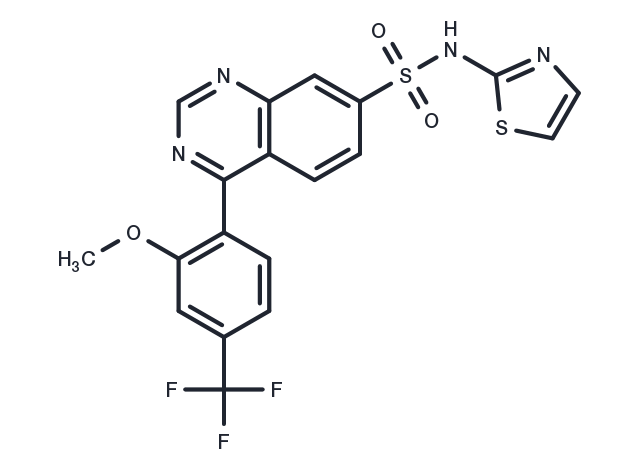Powder: -20°C for 3 years | In solvent: -80°C for 1 year


AM-2099 is a voltage-gated sodium channel Nav1.7 inhibitor (IC50: 0.16 μM).

| Pack Size | Availability | Price/USD | Quantity |
|---|---|---|---|
| 2 mg | 5 days | $ 56.00 | |
| 5 mg | 5 days | $ 89.00 |
| Description | AM-2099 is a voltage-gated sodium channel Nav1.7 inhibitor (IC50: 0.16 μM). |
| Targets&IC50 | Nav1.7 (human):0.16 μM, Nav1.7 (mouse):0.18 μM, Nav1.7 (rat):3.5 μM |
| In vitro | AM-2099 exhibits over 100-fold selectivity for the Nav1.7 channel compared to Nav1.3, Nav1.4, Nav1.5, and Nav1.8, with diminished selectivity observed for Nav1.1, Nav1.2, and Nav1.6. Its affinity for the hERG channel is low (>30 μM), and it lacks significant inhibition (>50%) against both a 100-kinase panel (1 μM) and a broad CEREP panel (10 μM)[1]. In heterologous cells, AM-2099 consistently inhibits NaV1.7 in human, mouse, dog, and cynomolgus monkey, showing decreased efficacy against rat NaV1.7. |
| In vivo | AM-2099 exhibits a dose-dependent escalation in plasma exposure accompanied by a simultaneous dose-dependent decrease in scratching bouts in comparison to vehicle-treated animals, notably achieving statistical significance at the 60 mg/kg dosage[1]. It also presents a favorable pharmacokinetic profile in both rats and dogs. In rats, AM-2099 is characterized by low total clearance, moderate volume of distribution at steady state (Vdss), and half-life. Conversely, in dogs, it features very low clearance, a low Vdss, and an extended half-life (18 h). |
| Molecular Weight | 466.46 |
| Formula | C19H13F3N4O3S2 |
| CAS No. | 1443373-17-8 |
Powder: -20°C for 3 years | In solvent: -80°C for 1 year
DMSO: 150 mg/mL (321.57 mM)
You can also refer to dose conversion for different animals. More
bottom
Please see Inhibitor Handling Instructions for more frequently ask questions. Topics include: how to prepare stock solutions, how to store products, and cautions on cell-based assays & animal experiments, etc.
AM-2099 1443373-17-8 Others AM2099 AM 2099 inhibitor inhibit
